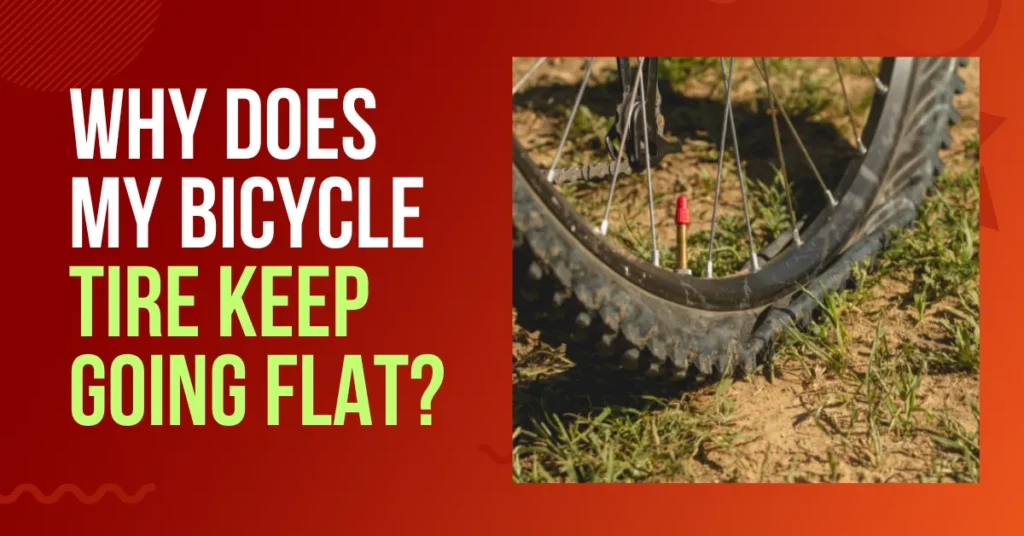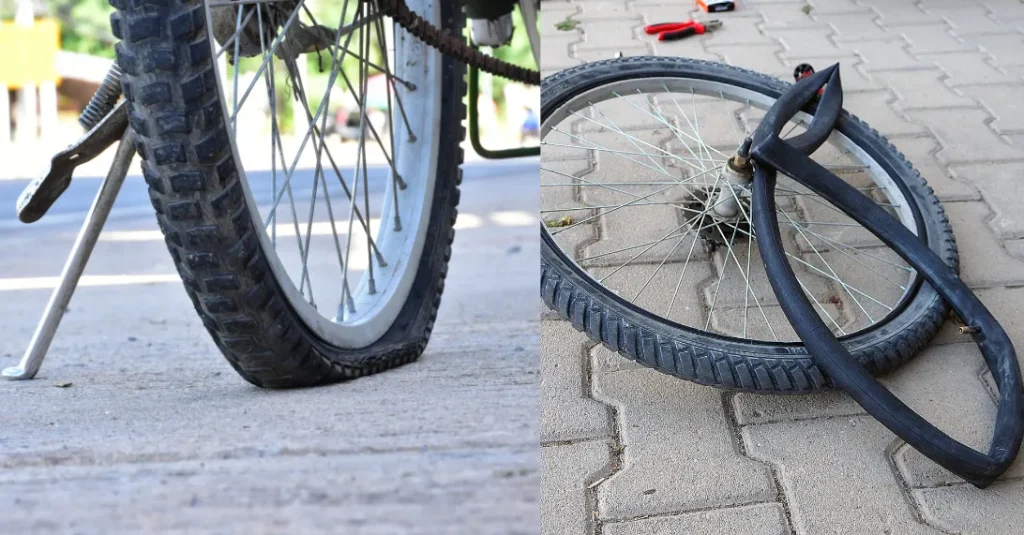
Having a bicycle tire that continuously goes flat can be very frustrating. However, there are usually some common reasons why this occurs. Understanding the root causes can help you fix the problem for good.
Common Causes of Flat Bicycle Tires
There are several common reasons why bicycle tires lose air and go flat:
Punctures
Punctures or small holes in the inner tube are a very common cause of flat tires. These holes allow air to gradually leak out until the tire is completely deflated. Punctures can be caused by:
- Sharp objects on the road – Glass, thorns, nails, tacks, etc can easily puncture a bicycle tire. Running over debris like this can put a tiny hole in your tube.
- Worn or underinflated tires – Tires that are worn too thin or underinflated are more susceptible to getting punctures from road debris. The less inflated a tire is, the more it can flatten against sharp objects.
- Rim tape issues – The rim tape can become damaged or improperly installed, which allows spoke holes or nipples in the rim to puncture the tube.
- Pinched tubes – If the tube gets pinched between the rim and tire during installation, it can create small punctures.
Faulty Valves
Issues with the valve stem can also lead to flat tires, such as:
- Damaged valve core – The thin valve core inside the stem can become cracked or damaged from overtightening or age, causing air leaks.
- Loose valve nut – The valve nut needs to be tight enough to secure the valve to the rim. If it is loose, air can escape around the valve.
- Valve stem not sealing – Sometimes the valve stem does not properly seal against the rim, allowing air to leak out. This may indicate worn out tubes.
- Valve extenders – Adding certain valve extenders can put stress on the valve and cause leaks.
Rim and Tire Damage
Holes, dents, or leaks anywhere on the wheel or tire can result in flats:
- Dented or cracked rims – Severe rim damage from impacts can warp the rim and break the seal with the tube.
- Damaged tire sidewalls – Cuts in the tire tread or sidewall allow air to escape. They can be caused by sharp impacts or worn tread.
- Tire seam leaks – Weak spots or manufacturing defects along the tread or sidewall seams can become leak points.
- Bead leaks – If the tire bead does not properly seat on the rim, air can leak through gaps between the bead and rim.
How to Find the Source of the Leak

Figuring out exactly where the leak is coming from is key to fixing flat tires for good. Here are some tips for locating the source:
Visually Inspect the Tire and Wheel
Carefully look over the entire wheel and tire assembly to spot any obvious holes, cracks, or damage. Spin the wheel slowly and look for any bubbles indicating leaks.
Check that the tire beads are properly seated all the way around both sides of the rim. Use soapy water to help bubbles become visible.
Examine the valve stem and pay attention to any cracks, damage, or loosening. Spray soapy water around the stem and look for bubbles.
Inflate the Tube and Listen
Remove the tube from the tire and inflate it just enough to give it shape. As you rotate it, listen closely for any hissing sounds of air escaping.
Run it under water and look for bubbles to find the leak source. Spraying dish soap mixed with water can also help.
Mark any leaks you find with chalk or a marker so you can locate them again after deflating.
Immerse the Tube in Water
Another method is to inflate the tube moderately and immerse the whole tube in a water-filled tub or bucket. Look for air bubbles escaping and mark the source.
This technique allows you to spot especially small or slow leaks that you may not hear otherwise.
Use a Tire Plugging Kit
Tire plugging kits contain liquid sealants that will bubble out of puncture holes. Inflate the tube, spread on the sealant, and look for foaming. This can help detect miniscule punctures.
Some bike shops have immersion tanks which make the process easier. But a DIY bucket works too.
How to Fix a Flat Bicycle Tire
Once you have identified the cause of the leak, you can apply the proper fix to stop the flats for good.
Patching Punctures
If you found a puncture hole in the tube, patch it from the inside using a bicycle tube patch kit. These contain glue and patches made especially for bike tubes.
See also: What is 26T in Cycle? – A Comprehensive Guide
Thoroughly sand the area around the puncture to roughen it so the glue adheres. Apply glue to both the sanded tube and the patch. Wait until tacky, then firmly press the patch over the hole and smooth it down.
Replacing Damaged Inner Tubes
If the puncture cannot be located or the tube is cracked or worn out, simply replace the tube with a new one. Make sure it is the proper size for your wheel.
Inspect the inside of the tire for any embedded debris that could re-puncture the new tube.
Fixing Valve Stem Issues
Tighten any loose valve nuts to prevent leaks. If the valve core is damaged, replace it with a new one using a valve core tool.
If the valve stem shows wear and no longer seals properly, replacing the whole tube is recommended.
Avoid valve extenders if possible, as they put stress on the stem.
Repairing Tire and Rim Damage
Significant tire or rim damage often requires replacement. Smaller holes in the tire tread can sometimes be patched with glue or a tire plug.
Reset any displaced tire beads back into the rim channel. Bent rims may need professional straightening or replacement.
How to Prevent Future Flat Tires
Flat tires are bound to happen occasionally no matter what. But there are things you can do to help avoid them:
Maintain Proper Tire Inflation
Keep tires inflated to the pressure recommended on the sidewall. Use a quality pressure gauge and check pressure regularly.
Underinflation is a major cause of punctures and pinched tubes. It also causes excessive wear.
Inspect Tires Frequently
Look over treads and sidewalls before each ride for cracks, cuts or bulges. Embedded glass or debris should be removed immediately.
Feel for adequate tread depth. Worn tires are more prone to punctures.
Avoid Road Hazards
Ride around potholes, broken glass, metal scraps or other sharp objects whenever possible. Going over them at an angle can help.
Use Tire Liners
Tire liners add an extra layer of puncture protection between the tube and tire. Thick rubber liners are the most effective.
Sealant Inside Tubes
Liquid sealants like Slime can be added into inner tubes to temporarily seal small punctures as they occur. It helps prevent complete deflation.
Install Thorn-Resistant Tubes
Heavy duty tubes made with thicker rubber and puncture sealant built-in can improve resilience against flats. Brands like Slime and ThornProof offer these tubes.
Convert to Tubeless Tires
Tubeless tires provide the ultimate in puncture protection. The sealant inside can plug multiple holes up to around 1/4 inch. Converting requires compatible rims and tires.
Frequently Asked Questions About Flat Bicycle Tires
Why does my tube keep getting punctured after patching a hole?
This usually happens when there is still a tiny piece of debris stuck inside the tire that is re-puncturing the tube. Make sure to thoroughly inspect the interior of the tire and remove any embedded fragments after getting a flat. Also check the rim strip for coverage of all spoke holes.
What size inner tube do I need?
The tube size is marked on the sidewall of the tire. It will be the tire diameter and width. For example, 26 x 2.125 inches. Inner tubes come in a range of sizes to fit various tire widths for each wheel diameter.
How do I find very small punctures?
Tiny punctures that leak slowly can be hard to locate just by listening or submerging. Use tire sealant or a bucket of water to help pinpoint the leak location. Mark it immediately and patch as soon as possible to prevent the hole from enlarging.
Why does my tire keep going flat even after patching?
If the leak continues after patching, the most common problem is an inadequate seal around the patch. Make sure the tube area is sanded thoroughly and both surfaces get coated in glue. Press the patch down firmly for a full minute to ensure a tight seal.
What is the white powder on my inner tube?
White powder on the inside of bike tubes is usually talcum powder or cornstarch. Tubes are dusted with this during the manufacturing process. It is not harmful, and helps keep the rubber from sticking together while packed.
When should I replace my old inner tubes?
Tubes that are repeatedly patched or have visible cracking, dry rot, or stretch marks are at the end of their lifespan. Old and weathered tubes are more prone to failure. Replacing them at least annually helps minimize flats.
Conclusion
Having to constantly reinflate bicycle tires due to flats can make riding frustrating. But there are definite techniques you can use find and fix the root causes.
Thoroughly inspecting wheels, valves and tubes can reveal punctures, leaks and damage. Making necessary repairs or replacements stops the flats for good.
By understanding why flats happen and how to prevent them, you can keep your bike’s tires pumped up and ready to roll. Utilizing proper maintenance habits will have you riding reliably for miles down the road.






